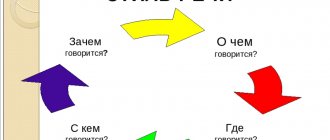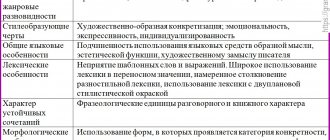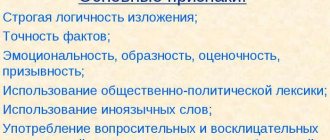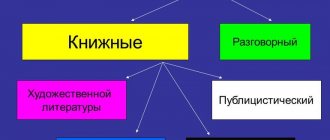A conversational style of speech is on the agenda. If you take and record our everyday conversation, you will most likely get a pun, or, better said, nothing good will come out of this idea at all. Those norms that are applicable for book speech may be completely unsuitable for colloquial speech.
In this article you will learn what a conversational style of speech is, what function it performs, read about the characteristic features, features and genres of a conversational style, and also find examples of this functional style of speech.
What is a conversational style of speech, its main function and scope of application
Conversational style of speech is a functional style, the main task of which is the direct transmission of information in an informal setting, most often in oral form (exceptions may be diary entries, notes, personal letters).
Thus, the main function of the conversational style is the communication function, which provides everyday, everyday connections between people.
The scope of application of this style is everyday relationships: in the family, among friends and acquaintances, communication with colleagues, in a store, on the street and in any other informal and informal setting.
In addition, the colloquial style of speech is found in artistic and journalistic styles for the purpose of reliable and realistic transmission, for example, a report from the scene of an event or to create the necessary atmosphere, character and appearance of a literary hero.
Read the articles:
- “Features, features, genres and examples of scientific style of speech.”
- “Features, characteristics, genres and examples of texts of official business style of speech.”
To design presentations, printed materials, publications, create logos, business cards or infographics, I recommend using the Canva program. This is a very simple and convenient all-in-one visual editor. With thousands of professional templates, images, and other quality elements, you'll get a great starting point to bring your best ideas to life.
Journalistic style
What are speech styles? These are its functional varieties that are used in one or another area of life:
- journalistic - media style;
- artistic - literature;
- business style is the language of documentation;
- colloquial is used in everyday life;
- scientific - in professional literature.
The scope of application is not the only thing that distinguishes the five existing styles from each other.
How to determine speech styles? Evaluate the text based on several criteria:
- his goal is what idea he wants to convey;
- vocabulary and genre;
- form - oral or written.
What are the features of journalistic style? It is used in media and public speaking. His goals:
- convince the reader (listener) of something;
- convey information;
- evoke an emotion;
- make you think.
Expressive, harsh expressions, value judgments and wordplay are acceptable here:
For the first time in his life and career, the director, who already has a cult status and an army of fans, was awarded a truly significant award.
By the way, “The Shape of Water” was only his second film competing at the festival, and the previous one, “Pan’s Labyrinth,” remained unnominated at Cannes. From outsiders - too strange for Hollywood, too pop for festivals - del Toro suddenly stepped into the favourites. Perhaps because he made his best film, for the first time finding the ideal balance of genre and authorship, universal and personal (Anton Dolin’s review of the film “The Shape of Water”).
Journalistic style of speech: Unsplash
Characteristics and features of conversational style
The characteristic features include :
- Oral form of speech.
- Informality and ease.
- Emotionality (in the form of a live reaction to people’s words and actions).
- Specificity.
- Simplicity and ordinariness of content.
- Use of colloquial vocabulary with a colloquial flavor.
In addition to the above characteristics, the conversational style of speech has a number of features and distinctive features :
- Most often it is implemented in the form of dialogue.
- Language material is not pre-selected.
- Facial expressions, gestures, and the surrounding environment are of great importance.
- Words are used in a figurative sense, there are incomplete sentences, addresses, interjections and particles, repetitions of words.
- The use of emotional words and expressions (nightmare, horror, victory, this is wonderful, etc.).
- Disorganized and fragmented speech (“A kilogram of apples, please.”).
- Intonation plays a special role: raising or lowering the tone, stretching vowels, pauses, changing the tempo of speech.
- Colloquial style vocabulary consists of common words (work, read, book, metro) and colloquial words (potato, giggle, butuz, scribble, hype).
- There are slang words (to fill up a place), colloquial words (dreary, sleepy, crazy) and slang words (teacher), professionalisms (non-cash, cash, turn on the meter), dialecticisms (pitching - duck, kuren - hut).
- Terminological, abstract vocabulary, as well as book words are almost not used.
- Law of economy of speech means. Very often, instead of two words, one is used: condensed milk - condensed milk, sick leave - sick leave; stable combinations are simplified: maternity leave - maternity leave.
- The conversational style is rich in phraseological units: sewn with white thread, touch a nerve, just a stone's throw away.
- To enhance emotionality, doubling of words is used, sometimes with exaggeration: big-very big, black-black water, quiet-quiet.
- Lots of pronouns (I, you, we) and verbs.
- Participles and gerunds almost never occur.
Scientific style
What features are inherent in the scientific style? It is the language of encyclopedias, textbooks, dissertations, monographs and scientific articles. As O. Stycheva, candidate of pedagogical sciences, notes, the scientific style is easy to recognize by the following features:
- professional terminology;
- evidence - the presence of facts, figures;
- strict adherence to spelling or pronunciation standards;
- objectivity and completeness of information.
There is no room for the author's subjective opinion here. The purpose of the text, presented in a scientific style, is to prove the truths revealed through research.
By the way, O. Stycheva’s article also serves as an example of such a text:
A characteristic feature of the style of scientific works is their saturation with terms, including international ones. L.V. Shcherba wrote that on average, terminological vocabulary in scientific information is about 25%, however, the collections of scientific works we analyzed indicate that, in general, the scientific style of Russian speech tends to increase this percentage
.
Scientific speaking style: Unsplash
Conversational style of speech: genres
Depending on the situation at the time of communication, the following genres (varieties) of conversational style of speech in oral form are distinguished:
- Conversation (conversation).
- Phone conversation.
Genres of conversational style in writing:
- A note.
- Communication via the Internet.
- SMS.
- Private letters.
- Entries in a personal diary.
Of course, the main genre of conversational style of speech is conversation or conversation. Depending on the number of participants, this may be a dialogue or monologue.
Dialogue is an exchange of remarks, questions and answers between two or more people. Dialogue is characterized by frequent changes of roles “speaker – listener”, so that the interlocutors alternately act in one or another role. Replies can also express addition, clarification, extension, agreement, objection, encouragement, etc.
Monologue is speech in the first person, addressed to the listener or to oneself, not intended for a response.
In a conversational style, dialogue and monologue in their pure form are rarely encountered: a monologue can be interrupted by remarks from the interlocutors, and the dialogue, in turn, can include mini-monologues and micro-stories.
Introduction.
People have been named in various ways: homo sapiens (reasonable man), homo fiber (producing man), and homo ludens (playing man). It seems that with no less justification he can be called hom communicans - a person communicating.
Russian thinker Pyotr Chaadaev (1794-1856) wittily remarked: “Deprived of communication with other creatures, we would pluck grass rather than reflect on our nature.” And he was right, since the natural way of a person’s existence is his connection with other people, and a person himself becomes a person only in communication.
The need for communication, according to psychologists, is one of the basic (basic) human needs. The importance of communication as a basic need is determined by the fact that “it dictates the behavior of people with no less power than, for example, the so-called vital (life) needs.” Communication is a necessary condition for the normal development of a person as a member of society and as an individual, a condition for his spiritual and physical health. Although human communication has always been the basis of people’s social existence, it became a direct object of psychological and socio-psychological analysis in the 20th century.
In psychology, communication is defined as the interaction of two or more people, consisting in the exchange of information between them of a cognitive or affective-evaluative (i.e., emotional-evaluative) nature.
Language is the most important means of human communication and an instrument of artistic creativity. The Russian literary language has spoken and written forms of expression. Written speech more strictly follows the rules of word formation and word usage established by normative grammar. Conversational speech is much freer in this regard. There is also a difference in the selection of some linguistic means. When talking with interlocutors, intonation and gestures often free us from the need to use complex and complete sentences and allow us to use rich, emotional words and expressions. We speak differently than we write, and if you record spoken language, it will look so unusual that you will involuntarily want to amend it in accordance with the norms of written speech. However, this should not be done, because colloquial speech is subject to its own norms and what is not justified in book speech is quite appropriate in casual conversation. Spoken speech forms a system that has its own characteristics at all tiers of the language structure: in phonetics (pronunciation, intonation), vocabulary, phraseology, word formation, morphology, syntax.
The role of communication in human life is enormous. Only after the emergence of verbal communications in primitive society was humanity able to move to a new level of development and continue to develop. Communication is characteristic of all higher living beings, but at the human level it takes on the most perfect forms, becomes conscious and mediated, i.e. speech. There is not even the shortest period of time in a person’s life when he is outside this process of life activity, outside interaction with other objects of society. Consideration of the communicative aspect of human life is not only interesting, but also valuable in the light of improving the mutual understanding of individuals in society. In modern life, people make purchases, make deals, and share information every day. The ability to behave with people during a conversation is one of the most important factors determining the chances of achieving success. A person’s success in his business, even in the technical field, depends only fifteen percent on his professional knowledge and eighty-five percent on his ability to communicate with the people with whom he works.
There is nothing simpler, and at the same time more complex, than the process of human communication. It is the source of our joys and sorrows, hopes and successes. There are no professions that do not require communication. The problem of communication - one of the most important and complex in psychology - is considered in various aspects. This:
- a person in the world of communications, in the process, conditions of implementing different forms of life, means of achieving different goals and satisfying different needs;
— structure, types and functions of communication.
Communication is an art and science where not only natural abilities are important, but also education. The effectiveness of work and success in achieving goals largely depends on the level of development of communication abilities.
Communication is a broad, multifaceted concept. A person reading a book communicates with the writer, and the writer communicates with the reader. A person is watching a play, giving a lecture, talking on the phone, talking to a friend - all this is communication. With all the differences in the understanding of the word “communication”, it is necessary to highlight the exchange between people of certain results of their mental activity - acquired information, thoughts, judgments, assessments, feelings. Usually, communication is included in the practical interaction of people: joint work, learning, collective play, etc.
Example text in conversational style
As an example of a conversational style of speech, below are excerpts from the books of the modern (brilliant) writer Fredrik Backman. The spoken language in his works comes out very realistic and lifelike.
An excerpt from Fredrik Backman’s book “Grandmother told me to bow and tell her that she asks for forgiveness”:
Stretching out on the floor, the grandmother rummaged under the bed and pulled out a package. It wasn't meat or cigarettes. These were sweets.
– You must give the chocolate to your Friend.
Several moments passed before Elsa realized which friend she was talking about.
Elsa looked at her grandmother in confusion:
- Bah, are you out of your mind? Do you want my death?
Grandma rolled her eyes.
- Stop being a fool. Are you saying that the knight of Miamas does not dare to go on a mission?
Elsa squinted her eyes offendedly:
- You take it weakly.
- Look at the root! - Grandma grinned.
Excerpt from Fredrik Backman's book Britt-Marie Was Here:
“I’ll sit here until you stop dying.” “If you want to eat, you’ll have lunch,” the Personality grinned and extended her hand to the half-eaten pizza lying on the stool.
- Lunch? Now? – Britt-Marie muttered, because it wasn’t even eleven.
- Do you want to eat? Here's pizza! – invited the Personality.
Only now did what was said reach Britt-Marie's consciousness.
– What do you mean “pulled”? Did they shoot at me? – she exhaled, feeling her head in search of an opening.
- Yes Yes Yes. Hit the head with a soccer ball,” the Personality nodded, spilling vodka on the pizza.
Judging by the look of Britt-Marie, she would prefer a gun to a ball. As a less dirty item.
PS: Did you like the article? Share the link on social networks! Thanks and have a nice day.
Sources used:
- E. Demidova “Style... Style... Style...”.
- GIA. Russian language. Universal reference book. Author: Angelina Rudneva.
- resh.edu.ru
- Photo - dreamstime.com
List of used literature:
1. Psychology and ethics of business communication. Ed. Lavrinenko V.N. 4th ed., revised. and additional - M.: Unity-Dana, 2005. - 415 p.
2. Business communication: Chernysheva L.I. Publisher: Unity-Dana, 2011. – 414s.
3. Business communication - Titova L.G. — Textbook, 2006. – 271s.
4. Borozdina G.V. Psychology of business communication: Textbook.— M.: INFRA-M, 2006. — 224 p.
5. Vvedenskaya L.A., Pavlova L.G., Kashaeva E.Yu. Russian language
and speech culture. – M.: Phoenix, 2011. – 511s.
Attention!
If you need help writing a paper, we recommend turning to professionals. More than 70,000 authors are ready to help you right now. Free adjustments and improvements. Find out the cost of your work
Free estimate
0
Size: 26.64K
Downloads: 131
06/01/13 at 11:30 Author: Svetlana_Skots
Liked? Click on the button below. It's not difficult for you
, and we
are pleased
).
To download test papers for free at maximum speed, register or log in to the site.
Important! All submitted Tests for free downloading are intended for drawing up a plan or basis for your own scientific works.
Friends! You have a unique opportunity to help students just like you! If our site helped you find the job you need, then you certainly understand how the job you add can make the work of others easier.
Add a job
If the Test work, in your opinion, is of poor quality, or you have already seen this work, please let us know.
Areas of use outside of conversations
As noted above, colloquial speech is most often used in oral communication. In addition, it is also used in the following areas:
- Informal email correspondence - communication through various chats. Conversational speech in this case helps to achieve brevity and save time. It is characteristic that emoticons and stickers serve as non-verbal communication channels: gestures, facial expressions and glances of those communicating.
- Fiction. Even classic writers often put colloquial speech into the mouths of their heroes, thereby creating a believable image. But usually such vocabulary is inherent in the so-called “low” genres of literature.
- Press. Elements of colloquial speech are also applicable to newspaper/magazine articles, for example, to enhance the expression of an expression. Mass print and online media also often resort to colloquial language to bring the content of publications closer to the understanding of the “ordinary” reader.
Word formation
Colloquial words can often be identified by the suffixes and prefixes with which they are formed.
Many nouns with suffixes are colloquial:
- -ak/-yak (“good man”, “fat man”);
- -an/-yan (“friend”);
- -ach (“stuntman”, “bearded man”);
- -ul- (“dirty”);
- -tyai (“lazy person”);
- -yag- (“hard worker”) and others.
The conversational style is characterized by adjectives with suffixes:
- -ast- (“toothy”, “big-eyed”);
- -enn- (“hefty”);
- -at- (“hairy”);
- -ovat- (“reddish”).
A number of colloquial verbs end in -nitchat and -ivat (“to be sarcastic”, “to walk”). Another group is words expressing a one-time action and formed with the suffix “-well-“ (“to spin”). Verbs with –ыва-/iva-, meaning long-term actions in the past (“walk”, “talk”), are also classified as colloquial.
This also includes many verbs with the prefixes for- and na- and postfix -sya. For example, “take a look”, “visit”.
Scheme for performing text parsing point by point
To carry out a stylistic analysis of any text, the following algorithm is used:
- Determine whether there is a main function, what speech tasks there are in the end. Availability of additional functions.
- Highlight the characteristic features.
- By what means can these features be created?
- What genre or scope of application.
- Determine which of these features are inherent in speech: emotionality, imagery, ease, accuracy, vagueness, subjectivity.
- Specifics of speech: phraseology, vocabulary, grammar. (Perhaps give an example passage.)
- Conclusion.
Phonetic features
This category includes features of the pronunciation of spoken language. The most striking of them are the following:
- "abbreviation" of words. Sounds may not be pronounced clearly, and some may be swallowed. Sometimes entire syllables are dropped from words. For example: “zdastye”, “goodbye”, “Ann Sergevna”;
- “stretching” vowels, which helps express an assessment or attitude towards the situation being described. For example, “The bread is so-a-a-a-a-a-a-a-a-a-a!”;
- use of local or regional pronunciations.
Morphological characteristics
In everyday communication, people strive to speak more simply and dynamically, and avoid “complex” forms of parts of speech. In particular, in colloquial speech they note:
- absence of participles (“raised”, “raised”), gerunds (“raised”, “put”). Also, short adjectives (“beautiful”, “kind”) are not used or only slightly used;
- widespread use of pronouns (“I”, “you”, “he”), particles (“only”, “hardly”, “let”, “what the”), interjections (“oh!”, “eh!”) . Sometimes they can consist of entire replicas: “(Is it) you?”, “And he (what did he do)?”, “Let (it be so)!”;
- reduced, compared to other speech styles, proportion of nouns;
- special vocative form: “Mom!”, “Vasya!”;
- frequent use of truncated forms of nouns (“ten kilograms”, not “kilograms”) and functional parts of speech (“so that”, “at least”);
- There is no declension for complex and compound numerals. For example: “Thirty forks are missing”, “Who wrote about twenty-six commissars?”;
- frequent use of present tense verbs in conversations about the past: “I was already going to bed yesterday, and he’s calling.”
Syntactic features
In most cases, spoken language uses simple rather than complex sentences. The following are common:
- interrogative and incentive sentences (“So how?”, “Let’s go!”);
- omission of sentence parts, which, however, does not interfere with understanding: “(I) am walking, I see - (you are) walking”;
- one-part sentences (“I can’t sleep…”, “Watermelons are already on sale”);
- word-sentences: “Yes”, “Excellent!”, “New?”;
- repetitions of the words: “I’m coming, I’m coming!”, “I’ve been waiting, waiting...”.
- frequent use of introductory words and sentences, plug-in constructions. For example: “You know, I wanted to go.”











